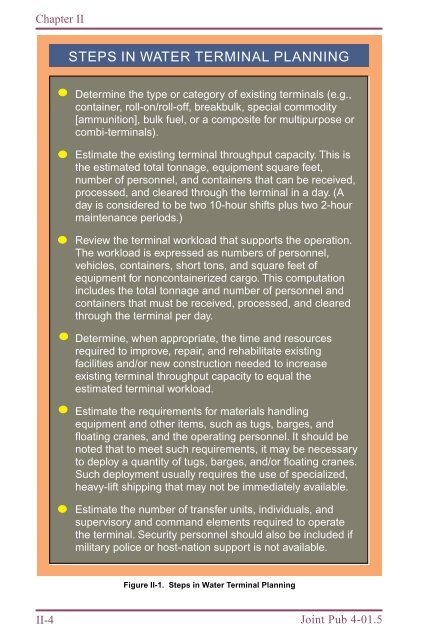JP 4-01.5 JTTP for Water Terminal Operations - BITS
JP 4-01.5 JTTP for Water Terminal Operations - BITS
JP 4-01.5 JTTP for Water Terminal Operations - BITS
You also want an ePaper? Increase the reach of your titles
YUMPU automatically turns print PDFs into web optimized ePapers that Google loves.
Chapter II<br />
II-4<br />
STEPS IN WATER TERMINAL PLANNING<br />
Determine the type or category of existing terminals (e.g.,<br />
container, roll-on/roll-off, breakbulk, special commodity<br />
[ammunition], bulk fuel, or a composite <strong>for</strong> multipurpose or<br />
combi-terminals).<br />
Estimate the existing terminal throughput capacity. This is<br />
the estimated total tonnage, equipment square feet,<br />
number of personnel, and containers that can be received,<br />
processed, and cleared through the terminal in a day. (A<br />
day is considered to be two 10-hour shifts plus two 2-hour<br />
maintenance periods.)<br />
Review the terminal workload that supports the operation.<br />
The workload is expressed as numbers of personnel,<br />
vehicles, containers, short tons, and square feet of<br />
equipment <strong>for</strong> noncontainerized cargo. This computation<br />
includes the total tonnage and number of personnel and<br />
containers that must be received, processed, and cleared<br />
through the terminal per day.<br />
Determine, when appropriate, the time and resources<br />
required to improve, repair, and rehabilitate existing<br />
facilities and/or new construction needed to increase<br />
existing terminal throughput capacity to equal the<br />
estimated terminal workload.<br />
Estimate the requirements <strong>for</strong> materials handling<br />
equipment and other items, such as tugs, barges, and<br />
floating cranes, and the operating personnel. It should be<br />
noted that to meet such requirements, it may be necessary<br />
to deploy a quantity of tugs, barges, and/or floating cranes.<br />
Such deployment usually requires the use of specialized,<br />
heavy-lift shipping that may not be immediately available.<br />
Estimate the number of transfer units, individuals, and<br />
supervisory and command elements required to operate<br />
the terminal. Security personnel should also be included if<br />
military police or host-nation support is not available.<br />
Figure II-1. Steps in <strong>Water</strong> <strong>Terminal</strong> Planning<br />
Joint Pub 4-<strong>01.5</strong>
















